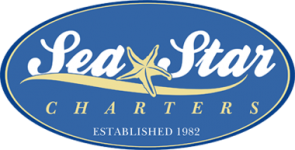Can Home School Groups participate in the Ocean Classroom Program?
Yes, it is a great family learning experience. Parents will learn as much as their children.
Is it safe to take students out to sea on an “Ocean Classroom” Expedition?
Yes, it is quite safe to do so. The “Sea Star” is inspected annually by the U.S. Coast Guard. The vessel meets or exceeds all of the required safety standards. The “Sea Star” is extremely well maintained and is most seaworthy. The captain is a an U.S. Coast Guard licensed “Master.” The crew is trained and safety is a top priority with them. As with any chartered outdoor experience, it is expected that the adults accompanying the students will exercise appropriate control over the behavior of the students.
When is the program offered?
Mid-October through May each year.
What grade levels are appropriate for this program?
Grades 2 through 12.
How many students can attend?
Generally we like up to 30 students and 6 adults. However, we can accommodate a few more if necessary.
What is a good student-to-adult ratio?
Generally one adult per 5 or 6 students is best.
We have a home school group. How many parents can attend with their children?
Home school groups should plan on a maximum of 30 participants (children and adults combined).
How long is the expedition?
About 3 hours.
What time do we board the boat?
Boarding times can be arranged to satisfy your group’s needs. Morning start times are recommended.
Is it possible to schedule two trips in one day?
Yes, the first trip would run from 9AM to 12PM. The second trip would run from 12:30PM to 3:30PM.
How much does it cost?
Up to 30 Students and 6 Adults - $1200
Up to 20 Students and 4 Adults - $1000
Up to 15 Students and 2 Adults - $900
Can students or adults reserve individual spots on a regularly scheduled expedition?
No, at this time we do not have any “open registration” trips scheduled. You would need to be part of a larger group which could then reserve a trip exclusively for that group.
How far in advance do we need to make a reservation?
Reservations are taken on a first come, first served basis. Generally 2 weeks to a few months is needed to find an available date.
Do we need to secure our reservation with a deposit?
Yes, generally a 50% deposit or purchase order number is required in advance of the actual trip date.
What happens if the weather is poor on our trip day?
If we cannot safely complete the trip, it will be rescheduled or your deposit refunded.
How long are we out on the open ocean?
About 1 Hour 15 minutes is spent collecting specimens at sea.
Will I get seasick?
Most people do not. You will only be exposed to open ocean for about 75 minutes. If you believe you may still feel uneasy, over-the-counter remedies are available to help alleviate the symptoms.
My group will be carpooling. How do we get to the “Sea Star” and where do we park?
There is abundant free parking adjacent to the “Sea Star’s” dock.
Can students eat while onboard?
There is a 20 minute lunch or snack break scheduled after our trawls are completed and we return to our working dock. Students should not be eating at any other time.
Should I bring a camera along?
Absolutely! It is a great way to record your students enjoying their new “hands on” learning experience.
